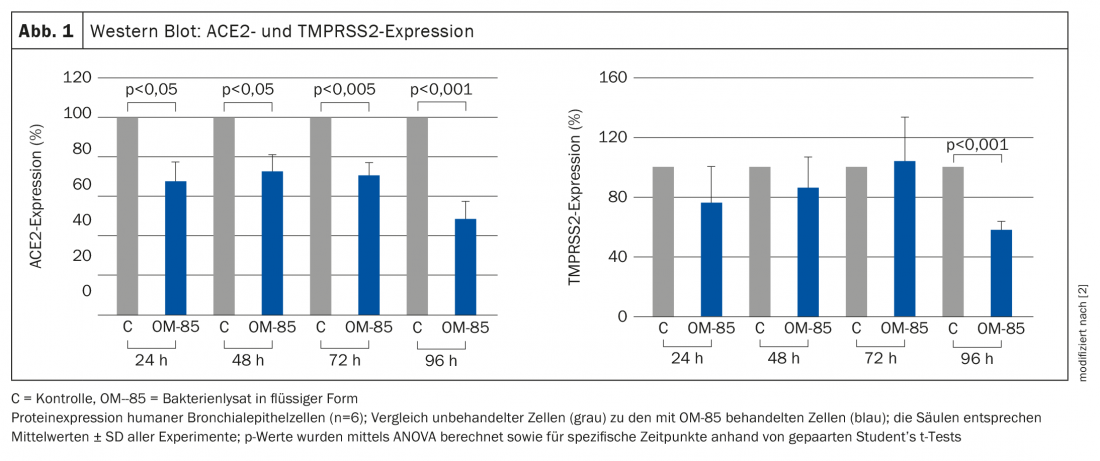Study results from a research team at the Department of Biomedicine at University Hospital Basel support the hypothesis that the bacterial lysate OM-85 may have utility in preventing SARS-CoV-2 infection and reducing the severity of Covid-19 disease. Laboratory experiments showed a reduction in the expression of membrane-bound ACE2 and of heparan sulfate as well as of the transmembrane protein TMPRSS.
Bacterial lysate-based drugs contain several strains of inactivated bacterial fractions, to which immunomodulatory effects are attributed. OM-85 (Broncho-Vaxom®) is a bacterial lysate approved in Switzerland for the preventive treatment of upper respiratory tract infections [1]. A potential prophylactic or therapeutic benefit of OM-85 with respect to SARS-CoV-2 infection is the subject of current research.
Immunohistochemical analysis of protein expression.
Scientists at the University Hospital of Basel isolated human bronchial epithelial cells from the two immortalized cell lines BEAS-2B and Nuli as well as primary human bronchial epithelial cells from patients without chronic inflammatory lung disease. Cell isolates were treated with OM-85 at various dilution levels (0, 1:10, 1:20, 1:50, 1:100) in cell culture medium for a period of 5 days [2]. Two application schemes were used: (i) single treatment at day 0 to investigate how durable the effects of OM-85 on protein expression are; and (ii) daily treatment with OM-85.
Quantitative PCR (qPCR) and Western blot were used to analyze the expression of angiotensin-converting enzyme 2 (ACE2), transmembrane serine protease 2 (TMPRSS2), and dipeptidyl peptidase-4 (DPP4), disintegrin, and metalloproteinases (ADAM17) [2]. The ELISA method was used to quantify various soluble proteins such as sACE2, heparan sulfate, heparanase, and hyaluronic acid.
Treatment of cells with OM-85 modulates relevant components
Data analyses showed that OM-85 resulted in significantly reduced expression of ACE2 and TMPRSS2 (p<0.001 for each) (Fig. 1) [2]. This finding is consistent with another in vitro study that also examined the effects of OM-85 on human epithelial tissue of target organs of the novel coronavirus [3]. Both enzymes play important roles in the infection process of SARS-CoV-2 because, in addition to ACE2 binding, activation of the spike protein by TMPRSS2 is required for virus entry into the cell [4]. Heparan sulfate expression was also significantly reduced in cells pretreated with OM-85 (p<0.01). Heparan sulfate was identified as a potential auxiliary factor of initial SARS-CoV-2 binding to the cell [5]. In contrast, the expression of ADAM17 (p<0.02) was significantly upregulated by OM-85, and the level of soluble ACE2 increased (p<0.05) [2]. Apparently, it is exclusively the membrane-bound ACE2 that facilitates virus entry, respectively, SARS-CoV-2 serves as a portal of entry into lung cells and other tissues [6]. In contrast, there is evidence that the soluble form of ACE2 competes for binding of SARS-CoV-2 virus, thereby impeding viral entry into the host cell and slowing infection [6].

Conclusion
All of the data presented in the study by Fang et al. observed effects of OM-85 were concentration- and time-dependent [2]. Overall, the results suggest that OM-85 is able to reduce the binding of SARS-CoV-2 S protein to epithelial cells by modifying host cell membrane proteins. According to study authors, this is an indication that OM-85 may be useful as an add-on to the treatment of covid-19.
Literature:
- Swissmedicinfo: Medicinal Product Information, www.swissmedicinfo.ch (last accessed Mar. 24, 202).
- Fang L, et al: Biomedicines 2021; 9(11): 1544.
- Pivniouk V, et al: Allergy Clin Immunol 2021.
- Hoffmann M, et al: Cell 2020; 181 (2): 271-228.
- Clausen TM, et al.: Cell 2020; 183: 1043-1057.e15
- “Soluble ACE2 at COVID-19 on the Bench,” www.deutsche-apotheker-zeitung.de/news/artikel/2020/04/02/loesliches-ace2-bei-covid-19-auf-dem-pruefstand (last accessed Mar. 24, 202).
HAUSARZT PRAXIS 2022; 17(4): 26












